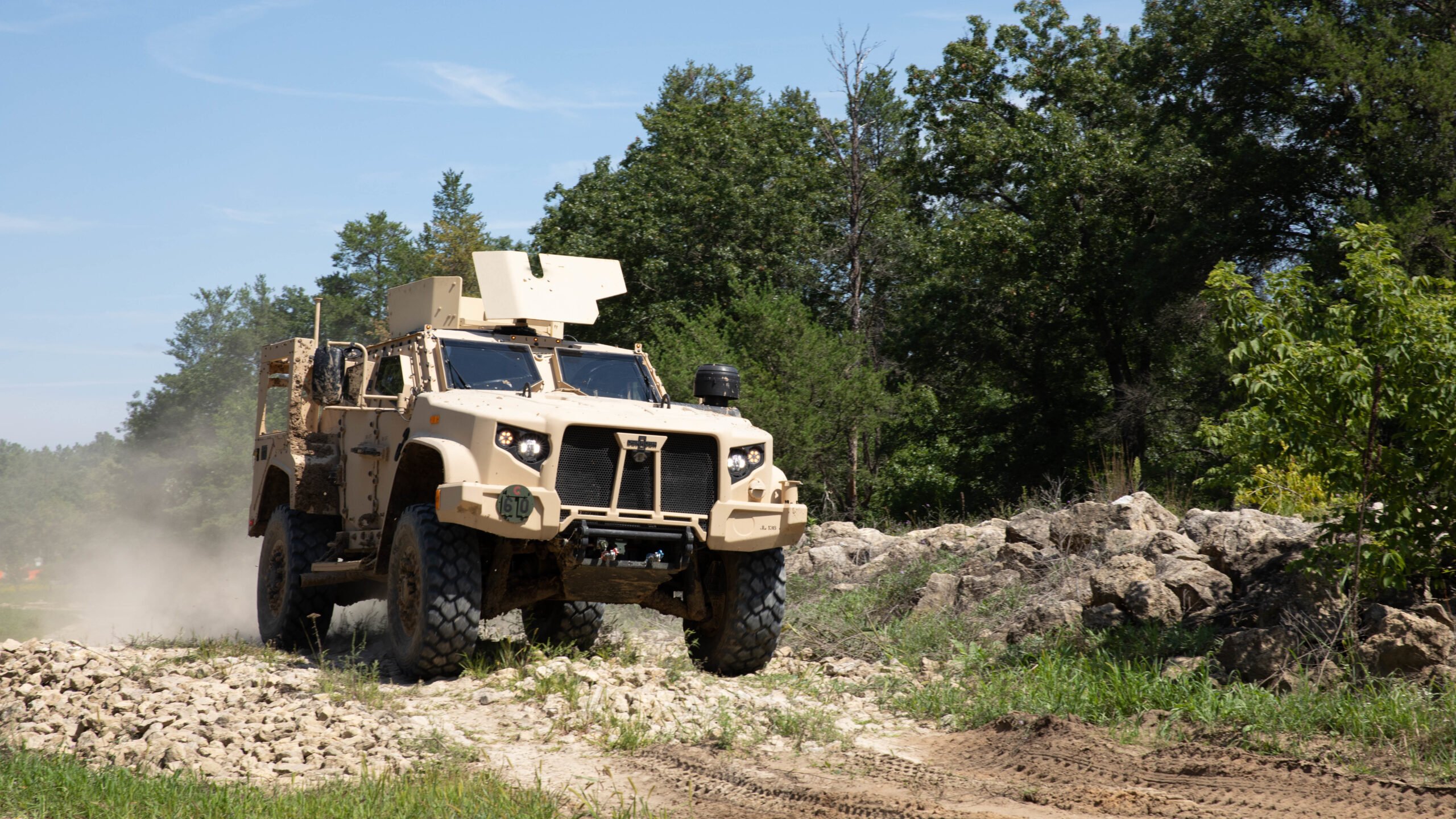
Driving through off-road obstacles showcases the Joint Light Tactical Vehicles’ capabilities to maneuver over uneven surfaces at Fort McCoy, Wisconsin, Aug. 17, 2022. (Spc. Brittney Joy/US Army)
AUSA 2022 — The US Army has a series of hybrid electric vehicle testing events scheduled for next year as it seeks to take advantage of the operational and environmental promise of the green technology.
While the service has been testing a hybrid-electric Bradley Fighting Vehicle this year, the Army’s Rapid Capabilities and Critical Technologies Office has contracts in place to integrate hybrid-electric technology on to a Joint Light Tactical Vehicle and High Mobility Multipurpose Wheeled Vehicle.
Driving the effort is the Army’s climate strategy, which aims to field “purpose-built” hybrid-drive tactical vehicles by 2035 and fully electric hybrid vehicles by 2050. The plan also aims to reduce the service’s greenhouse gas emissions by 50 percent of its 2005 levels by 2030.
Once RCCTO turned on its hybrid electric Bradley back in January, the Army began testing the first vehicle in July at Aberdeen Proving Ground, Md. with additional testing planned in September in Yuma, Ariz., a RCCTO spokesperson said in a statement. The second hybrid Bradley began testing in Yuma in August and both vehicles will be done with testing in December, the spokesperson said.
RELATED: Racing to ‘adapt,’ Army estimates climate plan will cost over $6.8B over 5 years
As the Bradley work ramped up earlier this year, the Army also awarded prototype Other Transaction Agreement contracts to begin hybridizing two other workhorse vehicles in its fleet, the Joint Light Tactical Vehicle and Humvees. According to the spokesperson, the contracts were awarded in March.
Both programs have the same set of goals. The first is to demonstrate the feasibility of hybrid electric power on tactical wheeled vehicles, in order to reduce the Army’s reliance on fossil fuels, a key component of the climate strategy. The second goal is to generate more organic power on-board, in order to power integrated weapon systems, sensors or other electronic equipment.
“In addition to being able to generate and store additional power, the … [vehicles] will also add an additional operational capability that will enable it to operate in a silent mobility mode (battery only),” the spokesperson said. “This additional on board power storage will also increase the… [hybrid vehicles’] silent watch capability over the non-hybrid variant.”
The hybrid Humvee OTAs, awarded to Gale Banks Engineering in Azusa, Calif. and Michigan Technological University in Houghton, Mich., run for 18 months. RCCTO said that testing will begin in September 2023 and finish in December next year.
AM General, the maker of the Humvee, is also expected to announce its own hybrid electric Humvee at some point this year, specifically targeting National Guard units.
“If any vehicle fleet in the US Army should be electrified in some fashion first, I think it should be the Humvee,” AM General CEO James Cannon told Breaking Defense in June. “You know why? It’s a utility vehicle, it’s not a combat vehicle.”
The hybrid JLTV effort is being led by MATBOCK, LLC., a small business company located in Virginia Beach, Va. According to the statement, the hybrid electric JLTV is a 15-month project, with testing beginning in June 2023 and finishing in September that year.
Major milestones for both programs include finishing the design reviews, vehicle builds, integration and facility checkouts, contractor testing and soldier testing, according to RCCTO.
“The intent of the Soldier Touch Points are to bring in Soldiers early into the projects life cycle to assist with informing requirements, provide operator and maintainer feedback on design decisions, and to ensure that we are building a prototype that provides an increase to the overall operational capability and functionality over the non-hybrid platform variant,” the spokesperson said.























